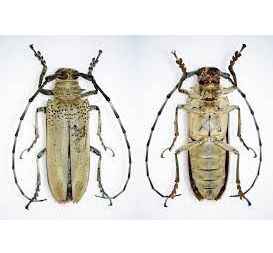 |
| Apriona cinerea |
Common Name: POPLAR STEM BORER
Scientic Name: Apriona cinerea Chevrolet
Order, Family: Coleoptera; Cerambycidae
Distribution:
A. cinerea is indigenous to the west Himalayan ranges of Nepal and adjoining areas of India and Pakistan.
Host Plants:
The major hosts of A. cinerea belong to the family Salicaceae(in particular Populus and Salix) and to Morus, Ficus, Prunus, and Pyrus species.
Life History:
- Beetle- Elongate, 26 -50mm in length, narrow, greyish to greyish-yellow, on the anterior side of elytra there is dense pubescence, the undersurface is black.
- The antenna is slightly longer than the body.
- The prothorax is wider than long, the sides are produced medially into a long spine pointing outwards.
- Elytra is shouldered.
Egg:
- Elongate – oval in shape, 7-8 mm long 3-3.2 mm wide, dirty creamish white, rounded at both ends, the cephalic end is broader than the other. Incubation period 5-7 days.
- Eggs are laid on the upper portion of the main stem or branch.
- The beetle peels a flap of bark and deposit one egg and seal the flap to conceal the egg. Incubation period 10-12 days.
Larva:
Creamy white in color, elongate, cylindrical, 60-70 mm long. Max. width at thorax 12mm.
The young larva bore down the stem and make an ejection hole at an interval of 10 cm.
The frass is accumulated at the base of the plant.
Larval period 16 -20 months.
Pupa:
- Extra or free, pale yellow in colour gradually darken at the time of maturity. Length – 50 mm and width 18 mm.
- Pupal period 18 -22 days. In young plants larva can not complete their life feeding on the stem so it bores down to the roots and pupate there.
- In older plants, pupation takes place inside the main stem only.
- The pupal chamber is oval, elongated, at the end of the larval tunnel and the entrance is plugged by long wood fibers or frass.
Life Cycle and Generations:
The beetle completes one life cycle in two years.
Nature of Damage:
- The main damage associated with Apriona spp. is caused by the larvae, which bore into the wood soon after hatching, creating long tunnels.
- Several larvae may be found in a tree.
- This affects the growth of the trees and decreases the quantity and quality of the timber and longevity of the trees
- The larvae bore down from the top of the stem to the roots.
- Due to the larval feeding, the stem becomes hollow and week.
- The young plants are outrightly killed.
- In old plants, all the larvae feeding on the branches bore down the branches and gathered in the stem.
- Due to the larval feeding, the stem becomes week and in the event of strong wind, it breaks.
Control Measure/ Management:
Mechanical
If the incidence is very low the affected plants should be uprooted and burnt in case of young plants. In old plants pruning of affected branches should be done after the monsoon before the larva reaches the main stem.
Chemical control
Injection of a saturated solution of paradichlorobenzene in kerosene oil in the lowermost ejection hole, after plugging the ejection hole on the upper side of the stem by wet clay. In nursery application of 10 grams of thimet at the base of the plant after soil working.



0 Comments